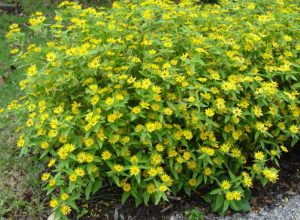Melampodium

Melampodium ‘Showstar’
* Common name: Melampodium or butter daisy
* Botanical name: Melampodium divaricatum
* What it is: Despite being a showy, drought-tough flower that the deer and bunnies don’t eat, melampodium has never caught on as a popular annual in Pennsylvania gardens.
Newer varieties bloom in a season-long mound of color with minimal need of water, fertilizer, and/or pruning or “deadheading” of spent flowers.
The flowers are button-sized and look like miniature sunflowers with yellow petals surrounding a gold center.
‘Showstar’ is the variety you’re most likely to find in garden centers (often the only one), although ‘Jackpot Gold’ scored a perfect five in the 2018 Penn State Trial Gardens.
* Size: Plants grow eight to 12 inches tall. Plant 12 to 15 inches apart.
* Where to use: Being native to the rocky soils of the Southwest U.S., Mexico, and Brazil, melampodium does best in full-sun locations and well drained soil. Try them in south- or west-facing foundation beds, along sidewalks and driveways, or around mailboxes.
* Care: Plant transplants after all danger of frost in spring (i.e. mid to late May). Keep soil consistently damp the first few weeks, then water needed only once or twice a week in the hottest, driest spells.
Work compost and timed-release flower fertilizer into soil at planting. Supplemental liquid flower fertilizer every month or so throughout the growing season maximizes bloom but isn’t required.
Deadheading and snipping also usually aren’t needed for the newer, compact varieties.
Yank and compost plants when frost kills them in fall.
* Great partner: Red celosia, red geraniums, and/or blue salvia make good annual partners. Melampodium also look good in and around red shrub roses or dark-leafed shrubs such as dwarf ninebark and Kodiak Black diervilla. Ornamental grasses and any green- or gold-foliage evergreen are good structural partners.







